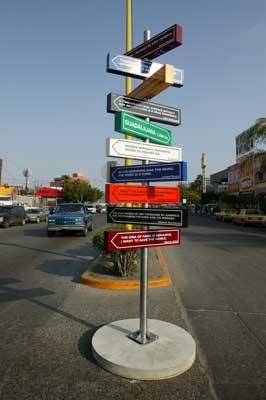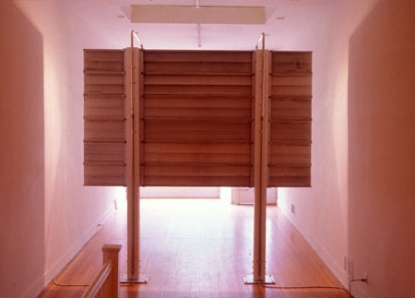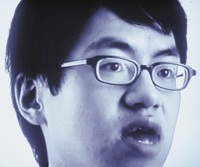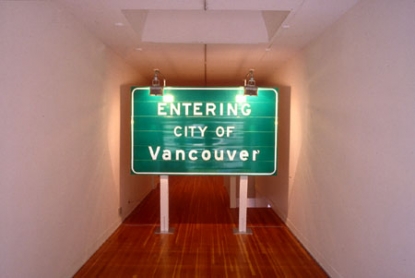Feature: Reviews
Baja to Vancouver
- CCA Wattis Institute of Contemporary Arts
- California College of the Arts
- September 23 - December 11, 2004
Much like the recent political conventions, Baja to Vancouver gathers established luminaries and rising stars into a rally that attempts to define group identity. Were B2V to have the politicos’ national stage it, too, could preach beyond the choir, wooing those who remain undecided about West Coast art. The curatorial thrust does double West Coast duty: “it is a tightly focused survey of representational artworks [by West Coast artists] that respond to and engage with the West Coast’s physical and social landscapes.” Themes that crop up—landscape and geography, pop and celebrity culture, and racial identity—are certainly not explored only by West Coast artists, but here they become defining aspects of West Coast history and cultural experience. From these loose categories emerge the broader universal binary issues of public/private, reality/performance, individual/society, cultural/political.
For some artists the strategy is to take ownership of shopworn clichés about the West Coast and redefine them. Evan Holloway’s Incense Sculpture (2001), riffs on 1970s public sculpture and hippie culture. His plaster mobius strip cum incense holder suggests self-indulgence, its rough craft declaring that Los Angeles art has outgrown its finish fetish. Other works take literal signs from the landscape and tweak them to examine the arbitrariness of geographic labels and boundaries, and the uncontested impact they make. The personal messages in Ken Lum’s pseudo-small business signage remind us that behind every public persona is a whole life filled with its own success and tragedies. This intersection of self and world is pointedly addressed in Marcos Ramirez ERRE’s Crossroads (Tijuana/San Diego) (2003) which locates the direction and distance from Tijuana to other cities; on the reverse of each placard are quotes from those cities’ artworld heavy-hitters: Pablo Picasso, Jackson Pollock, Jose Clemente Orozco, Joseph Beuys, Marcel Duchamp, Jeff Wall, etc. Conceived as mobile works exhibited partout, Crossroads and Ron Terada’s Entering City of Vancouver (2002)—an interstate-style green sign complete with floodlights—become wormholes to their cities of reference, issues of political geography, and the significant role artists play in cultural identity and that cultural identity plays in art.
In a similar strategy of using a recognized format as part of the message, video seemed to dominate this exhibition, though, in fact, it only comprised nine of fifty-six total works. Perhaps this perception is because any work with an audio component and/or its own darkened room demands attention. When asked if video is used more on the West Coast or seen as a very “West Coast kind of medium,” co-curator Ralph Rugoff replied that while video is used everywhere, the way in which it is used here reflects the influence and a more sophisticated understanding of the neighboring entertainment industry.
A case to his point is Delia Brown’s Pastorale whose blaring soundtrack transformed its environment, setting a certain mood in which the rest of the work in the gallery was left to be considered. With slick pop video mimicry, hypnotic R and B vocals by Goapele, and fluid, rolling camerawork, Brown draws us into the onscreen utopian party where beautiful multicultural families mingle in a beautiful home. We stand before the wide screen (as if in Circuit City) trying to parse the details that distinguish this work from standard MTV fare. What emerges most readily is the power of context. Only viewers seeing this piece in a gallery would deconstruct it as an artwork about artifice and the conventions of music video and fashion shoot. But unlike Cindy Sherman, whose work always apes, but is never confused for its source material, Brown’s success as a double agent keeps us guessing, to the point of enjoying the work more for its easy, surface “music video” qualities than its coded message. The danger in this assignment is one of mistaken identity, especially in this ever-shrinking (or expanding) world in which art and entertainment are melted together by the heat of spectacle.
Where Brown uses Hollywood convention as a Trojan horse, Tim Lee uses popular music to a much less glamorous and more cerebral effect. In his three-channel video, The Move, The Beastie Boys, 1998 (2001), Lee reciteséin deadpan without musical accompanimentéthe song’s tag-team lyrics. On each monitor he raps one of the three roles, syncing them up so that he is a one-man band, “faithfully” reproducing the Beastie Boys’ hit. The immediate impact is one of humor, driven by the substantial contrast between Lee’s anti-cool rendition and the in-your-face iconoclasm of the original. Where the B-Boys were all raw energy and emotion, Lee’s black-and-white headshot composition and pokerfaced delivery give the footage the glamour of a video-recorded legal deposition, with a nod to early video art. Yet it remains mesmerizing because Lee’s real focus is, of course, not the band or the lyrics themselves, but the effects of appropriation, translation and reinterpretation. In his performance, Lee reminds us that much of the what we experience in watching and listening to a performance is wrapped up in the music, delivery, choreography, clothes, etc. not the lyrics themselves.
Here, with the hit stripped of everything but the words, we see how popular culture travels from the stage and airwaves into the consciousness and verbal repertoire of the average person. His strategy of appropriation and restaging points out how art and entertainment can be consumed, reconfigured, and absorbed into identity, an idea made richer by the fact that an Asian-Canadian (Lee) is adopting the legacy of Jewish-American rappers who appropriate the style of African-American hip hop which is, in itself, a confluence of many global and historic influences.
As with Delia Brown’s work, Shannon Oksanen and Scott Livingstone’s Vanishing Point succeeds in stirring (or creating?) emotion, but their point of departure is the classic cult film of the same title from 1971. Melancholic surfer music accompanies grainy footage of a lonely surfboard rolling in the waves. Though a remade scene from the original, Oksanen and Livingstone’s version seems more rebuttal than homage to the counterculture, which, back then, confirmed the West Coast as its ground zero.
Here, the unexpected, metaphoric and graceful beauty of the board is akin to Gabriel Orozco’s stream of sublime everyday images in Recordings (1998). Not only do we enjoy watching these objects, but we are reminded of the pedestrian beauty that surrounds us if we only look.
Althea Thauberger’s aspiring songstresses—found through want ads in a local paper—were recorded singing their original ballads in outdoor settings. As discrete segments, it is hard to distinguish the performances from regular, if not amateurish, music videos. The corny sincerity of their efforts and the natural setting attempt to conceal the artificial nature of the endeavor, but seen as a continuous, looped piece, the repetitious elements in them (the environment, the same plaintiveness, the static poses) offer the work—and the singers—up as a mocking audition.
Other artists go one step further in exploring the cult of actual or aspiring celebrity. In her Untitled (1998-9) video, a jumping Trisha Donnelly apes in mid-air the on-stage poses of rock stars such as David Lee Roth and Iggy Pop. These signature moves are remarkably successful in conjuring our memories of the original performances, intimating how the mind uses certain unique gestures or details as shorthand for entire experiences. Catherine Sullivan, instead, uses soundless gesture to create—and ultimately refuse—new stories. InLittle Hunt (2002), two actors incorporate random props (from a production of Les Miserables) into a choreographed routine of their devising. The result is cryptic performances in which the viewer must surrender conventional notions of narrative and setting.
Though Michele O’Marah—like Oksanen & Livingstone—recreates existing footage, she is also true—like Lee—to the dialogue. But rather than music or film, her sources are “non-fiction” and “proto-fiction.” In White Diamonds and Agent Orange (2001) she juxtaposes her own very homemade remakes of an interview with Elizabeth Taylor and Richard Burton with boilerplate scenes from war movies. The Saturday Night Live-like rendition of both channels reinforces the fictitious truth of interviews and Hollywood-made movies while juxtaposing the self-absorption of celebrity with the death and carnage that was happening at the same time in history. The well-chosen inclusion of Kota Ezawa’s Who’s Afraid of Black, White and Grey? (2003)—a reductive graphic remake of scenes from Taylor and Burton’s unsettling 1966 movie, Who’s Afraid of Virginia Woolf—amplified the bourgeois brutishness the actors represent.
Matt McCormick takes a different angle in exposing the fallacy of documentaries. The Subconscious Art of Graffiti Removal (2002) convincingly imitates the genre, examining at its subject with interviews art historical “authority.” As in Brown’s video, it is convincing in its guise and subversive in its message: gullible and uninitiated viewers beware!
The overarching exploration of the video works—the codes of language, gesture, identity, truth, and artifice—are supported by the photographic works in the exhibition. Larry Sultan‚Äôs The Valley series captures moments in the suburban life of the porn industry, exposing its nuts, bolts and un-filmic moments while Stan Douglas uses movie conventions to turn the seediest urban underbelly into what looks like a studio set. In his peripatetic travels, Glenn Rudolph brings a romanticized and art-historically informed perspective to the sites and people of the Northwest, documenting its changes over the last decade. Rather than survey like Rudolph, Steven Shearer seeks a specific portrait on his travels over the Internet: people with their guitars. Astutely installed next to Donnelly’s air guitar video, Guitar #5 (2002-3) is a collage of photos downloaded from Web sites which juxtaposes the earnestness of some amateur musicians with the rock star fantasies of others. As a whole, it describes the porosity between public and private self, a self that can be publicly promoted and privately downloaded.
Baja to Vancouver is an excellent view of the concerns dominating the art on our coast for the last five years. Its focus on camera-made works reflects not only a universal trend, but a specific subset that could only arise under the unique cultural, political, industrial and geographic circumstances that are the West Coast. At least there is a thorough catalogue and Web based reviews to convince delegates from the rest of the states.




